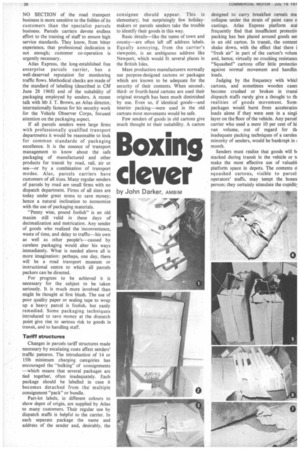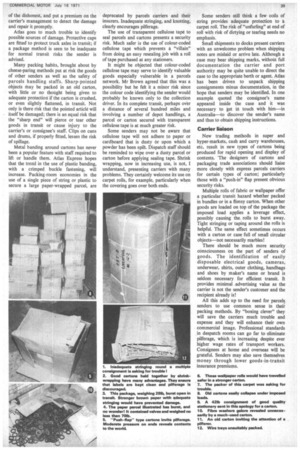Boxing clever
Page 40

Page 41

If you've noticed an error in this article please click here to report it so we can fix it.
by John Darker, AMBIM NO SECTION of the road transport business is more sensitive to the foibles of its customers than the specialist parcels business. Parcels carriers devote endless effort to the training of staff to ensure high service standards. They know, from bitter experience, that professional dedication is not enough; customer co-operation is urgently necessary.
Atlas Express, the long-established free enterprise parcels carrier, has a well-deserved reputation for monitoring traffic flows. Methodical checks are made of the standard of labelling (described in CM June 28 1968) and of the suitability of packaging employed by senders. A recent talk with Mr J. T. Brown, an Atlas director,' internationally famous for his security work for the Vehicle Observer Corps, focused attention on the packaging aspect.
If all parcels senders were large firms with professionally qualified transport departments it would be reasonable to lOok for common standards of packaging excellence. It is the essence of transport management to know about the safe packaging of manufactured and other products for transit by road, rail, air or sea—or by a combination of transport modes. Alas, parcels carriers have customers of all sizes. Many regular senders of parcels by road are small firms with no dispatch department. Firms of all sizes are today under great stress to save money; hence a natural inclination to economize with the use of packaging materials.
"Penny wise, pound foolish" is an old maxim still valid in these days of decimalization and metrication. Any sender of goods who realized the -inconvenience, waste of time, and delay to traffic—his own as well as other people's—caused by careless packaging would alter his ways immediately. What is needed above all is more imagination: perhaps, one day, there will be a road transport museum or instructional centre to which all parcels packers can be directed.
For progress to be achieved it is necessary for the subject to be taken seriously. It is much more involved than might be thought at first blush. The use of poor quality paper or sealing tape to wrap up a heavy parcel is foolish, but easily remedied. Some packaging techniques introduced to save money at the dispatch point give rise to serious risk to goods in transit, and to handling staff.
Tariff structures Changes in parcels tariff structures made necessary by escalating costs affect senders' traffic patterns. The introduction of 14 or 15Ib minimum charging categories has encouraged the "bulking" of consignments —which means that several packages are tied together, often inadequately. Each package should be labelled in case it becomes detached from the multiple consignment "pack" or bundle.
Part-lot labels, in different colours to show depot of origin, are supplied by Atlas to many customers. Their regular use by dispatch staffs is helpful to the carrier. In each separate package the name and address of the sender and, desirably, the consignee should appear. This is elementary, but surprisingly few holidaymakers or parcels senders take the trouble to identify their goods in this way.
Basic details—like the name of town and county—are often left off address labels. Equally annoying, from the carrier's viewpoint, is an ambiguous address like Newport, which would fit several places in the British Isles.
Mass production manufacturers normally use purpose-designed cartons or packages which are known to be adequate for the security of their contents. When second-, thirdor fourth-hand cartons are used their original strength has been much diminished by use. Even so, if identical goods—and interiar packing—were used in the old cartons most movements Would be safe.
Few senders of goods in old cartons give much thought to their suitability. A carton designed to carry breakfast cereals ma: collapse under the strain of paint cans a castings. Atlas Express platform stal frequently find that insufficient protectiv packing has ben placed around goods sea in an old carton. In transit, the content shake down, with the effect that there i "fresh air" in part of the carton's volum and, hence, virtually no crushing resistance "Squashed" cartons offer little protectio; against normal movement and handlin, loads.
Judging by the frequency with Whicl cartons, and sometimes wooden cases become crushed or broken in transi dispatch staffs rarely give a thought to thi realities of goods movement. Somi packages would burst from acceleratio; loads alone if they were sent in a sing!, layer on the floor of the vehicle. Any parcel carrier who used a mere 10 per cent of hi; van volume, out of regard for till inadequate Packing techniques of a careles; minority of senders, would be bankrupt in ; month.
Senders must realize that goods will bi stacked during transit in the vehicle or te make the most effective use of valuabll platform space in depots. The contents a squashed cartons, visible to parcel: operators' staffs, may tempt the hones person; they certainly stimulate the cupidit] of the dishonest, and put a premium on the carrier's management to detect the damage and repair it promptly.
Atlas goes to much trouble to identify possible sources of damage. Protective caps are fitted to protect truck axles in transit; if a package method is seen to be inadquate for normal transit risks the sender is advised.
Many packing habits, brought about by cheese-paring methods put at risk the goods of other senders as well as the safety of parcels handling staffs. Sharp-pointed objects thay be packed in an old carton, with little or no thought being given to adequate protection if the carton is crushed, or even slightly flattened, in transit. Not only is there risk that the pointed article will itself be damaged; there is an equal risk that the "sharp end" will pierce or tear other goods in transit or cause injury to the carrier's or consignee's staff. Clips on cans and drums, if properly fitted, lessen the risk of spillage.
Metal banding around cartons has never been a popular feature with staff required to lift or handle them. Atlas Express hopes that the trend in the use of plastic banding, with a crimped buckle fastening, will increase. Packing-room economies in the use of a single piece of string or plastic to secure a large paper-wrapped parcel, are deprecated by parcels carriers and their insurers. Inadequate stringing, and knotting, clearly encourages pilferage.
The use of transparent cellulose tape to seal parcels and cartons presents a security risk. Much safer is the use of colour-coded cellulose tape which prevents a "villain" from doing an easy resealing job with a roll of tape purchased at any stationers.
It might be objected that colour-coded cellulose tape may serve to identify valuable goods especially vulnerable in a parcels network. Mr Brown agreed that this was a possibility but he felt it a minor risk since the colour code identifying the sender would probably be known only to the collection driver. In its complete transit, perhaps over a distance of several hundred miles and involving a number of depot handlings, a parcel or carton secured with transparent cellulose tape is at much greater risk.
Some senders may not be aware that cellulose tape will not adhere to paper or cardboard that is dusty Or upon which a powder has been spilt. Dispatch staff should be reminded to wipe over a dusty parcel or carton before applying sealing tape. Shrink wrapping, now in increasing use, is not, I understand, presenting carriers with many problems. They certainly welcome its use on carpet rolls, for example, particularly when the covering goes over both ends. Some senders still think a few coils of string provides adequate protection to a carpet roll. The risk of "unfurling" at end of roll with risk of dirtying or tearing needs no emphasis.
Small shipments to docks present carriers with an unwelcome problem when shipping notes are mislaid or arrive late. Although a case may bear shipping marks, without full documentation the carrier and port authority may be quite unable to direct the case to the appropriate berth or agent. Atlas has been driven to unpack shipping consignments minus documentation, in the hope that senders may be identified. In one example quoted the consignee's name appeared inside the case and it was necessary to get in touch with him—in Australia—to discover the sender's name and thus to obtain shipping instructions.
Carrier liaison
New trading methods in super and hyper-markets, cash and carry warehouses, etc, result in new types of cartons being produced for rapid opening and display of contents. The designers of cartons and packaging trade associations should liaise more closely with express parcels carriers for certain types of carton; particularly those with a "push-in" flap present obvious security risks.
Multiple rolls of fabric or wallpaper offer a particular transit hazard whether packed in bundles or in a flimsy carton. When other goods are loaded on top of the package the imposed load applies a leverage effect, possibly causing the rolls to burst away. Tight stringing or taping around the rolls is helpful. The same effect sometimes occurs with a carton or case full of small circular objects—not necessarily marbles!
There should be much more security consciousness on the part of senders of goods. The identifidation of easily disposable electrical goods, cameras, underwear, shirts, outer clothing, handbags and shoes by maker's name or brand is seldom necessary for efficient transit. It provides minimal advertising value as the carrier is not the sender's customer and the recipient already is!
All this adds up to the need for parcels senders to use common sense in their packing methods. By "boxing clever" they will save the carriers much trouble and expense and they will enhance their own commercial image. Professional standards in despatch rooms can go far to eliminate pilferage, which is increasing despite ever higher wage rates of transport workers. Consignees at home and overseas will be grateful. Senders may also save themselves money through lower goods-in-transit insurance premiums.




























































































